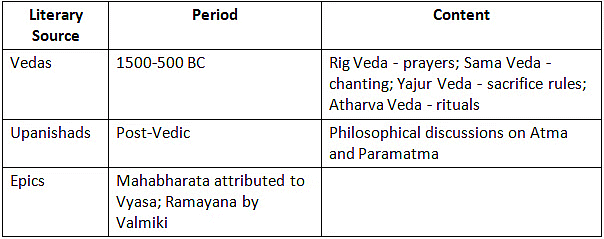Cheat Sheet: Prehistoric Period & Sources of Ancient History | History for UPSC CSE PDF Download
| Table of contents |

|
| Introduction |

|
| Literary Sources |

|
| Non-Literary Sources |

|
| Pre-historic India: Periods |

|
| Stone Age |

|
| Iron Age |

|
| Key Archaeological Discoveries |

|
Introduction
History, derived from the Greek word "historia," meaning inquiry, encompasses the study of the past. Pre-historic India, marked by the absence of writing and development, can be classified into five distinct periods: Paleolithic, Mesolithic, Neolithic, Chalcolithic, and Iron Age. To reconstruct this history, various sources, including literary and non-literary, play a crucial role.
Literary Sources
Religious Literature


Sutras

Buddhist Texts
 Early Buddhist texts
Early Buddhist texts

Jaina Texts

Secular Literature

Sangam Literature


Non-Literary Sources
Inscriptions

Coins


Archaeology

Foreign Accounts

Pre-historic India: Periods

Stone Age

Palaeolithic Age
 Mesolithic Period
Mesolithic Period
 Neolithic Period
Neolithic Period

Chalcolithic Age (Stone Copper Age)

Iron Age

Key Archaeological Discoveries

Thus, Pre-historic India unfolds a fascinating narrative through literary and non-literary sources. From the religious and secular literature shaping cultural understanding to inscriptions, coins, archaeology, and foreign accounts providing historical context, the rich tapestry of India's past comes to life. The progression through different periods, from Stone Age to Chalcolithic Age, showcases the evolution of human societies and their cultural, economic, and technological advancements. As we explore the history of pre-historic India, these sources show how strong and clever our ancestors were.
|
216 videos|855 docs|219 tests
|
FAQs on Cheat Sheet: Prehistoric Period & Sources of Ancient History - History for UPSC CSE
| 1. What are the main types of literary sources used to study the Stone Age? |  |
| 2. How do non-literary sources complement our understanding of the Stone Age? |  |
| 3. What is the significance of studying the Stone Age in ancient history? |  |
| 4. What are some examples of archaeological findings from the Stone Age? |  |
| 5. How do historians determine the age of artifacts from the Stone Age? |  |
















